TOKYO’S MAIN DISTRICTS AND WARDS
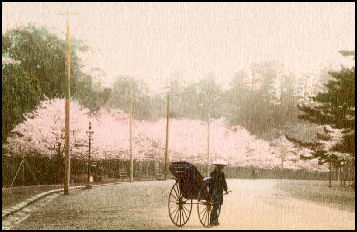
Ueno Park in
the early 20th century Tokyo’s main districts and wards of interest to tourists — Shinjuku, Shibuya, Ikebukuro, Ueno, Nihombashi, Shimbashi and Ginza — are fast-paced, energetic and busy and seem to rarely take a pause for a rest. Each has its own special characteristics and many seem to draw a particular kind of crowd. Among their main draws are restaurants, places to grab a quick, tasty snack, boutiques, mammoth department stores and numerous specialty shops.
Marunouchi (west side of Tokyo Station) is the largest office area and business hub in Japan. It is dotted with headquarters of leading banks and trading firms. The rows of glass and steel buildings here create a striking contrast to the nearby Imperial Palace. Many of the office towers have promenades running through them lined by fancy stores. The construction of replacements for old buildings is presently being promoted, and compound buildings with offices, shops and first-class hotels are going up one after another.
Ikebukuro (about five kilometers north of Shinjuku) is an important downtown area. Popular with ambitious young history and up and comers, it has been the setting for many TV dramas and novels in recent years. Ikebukuro has two of Japan's largest department stores (Seibu and Tobu), the second busiest station in Tokyo, the world's largest automobile showroom, a smell-reality sensuround theater (Toyota Amlux) and a super long escalator (at Tokyo Metropolitan Art Space). Most of the interesting stuff is one the east side of the station. Ikebukuro Map: Tokyo Essentials tokyoessentials.com
Sunshine 60 Building (in Ikebukuro) is one of the tallest buildings in Asia. It is 60 stories high and also boasts the world's former fastest elevator which ascends 60 floors in 35 seconds. Here you find Sunshine City, a shopping and entertainment complex with an observatory 240 meters (787 feet) off the ground, along with Namco Namja Town (an indoor theme park), the Sunshine International Aquarium, the Konica Minolta planetarium and the Ancient Orient Museum. Website: Wikipedia Wikipedia
Fukagawa (east side of the Sumida River) is a rough and tumble old school Tokyo district known for its fishermen, wood merchants and mid-level geisha houses. In shops here you can find beauty creams made from the feces of nightingales. In the Edo Museum an Edo-period street has been re-created in a large underground hall. Along the street wooden boats bobs up and down in a simulated river, mechanical cats roam the roof tops and recorded rice vendors call from loudspeakers.
Shinjuku, Shibuya and Harajuku
Shinjuku, Shibuya and Harajuku are three important entertainment and shopping areas in Tokyo. Shinjuku (Shinjuku Station) is a high-rise shopping and entertainment hub. JR Shinjuku Station is an immense terminal, which serves the most passengers of any station in Japan. Shinjuku is split into three major areas: 1) Shinjuku Street, 2) the Kabukicho district, the main sleaze area, and 3) the area on west side of Shinjuku station. Shinjuku Street (pedestrian-only on Sundays) is a shopping area lined with large department stores, fashionable specialty shops, restaurants and bars. Golden Street was a center the avant garde scene in the 1960s. Now it features dozens of little bars ensconced in spaces formally occupied by brothels. Many of the bars have regular customers who often look a bit shocked when strangers or foreigners come in.
Shibuya (Shibuya Station) is one of Tokyo's most happening places. Known for its rowdy nightspots, noodle restaurants, shopping arcades, flashing lights, huge display screens, department stores, boutiques, hostess bars, and smokey clubs, it is a place where executives and salary men gather to drink heavily, young people hang out, tourists experience Tokyo’s intensity, women shop and huge crowds cross the streets
Harajuku (one stop from Shibuya on the JR Yamanote line) is a neighborhood popular with fashion-conscious teenagers, who tend to congregate around the record stores and clothes shop. There are also many trendy shops, such as Condomania, restaurants and tea shops in the area. The pedestrian overpass from Harajuku station to Meiji Shrine and the narrow alley of Takeshita Dori is favorite gathering place for young Japanese who like to dress in outrageous cosplay costumes and relish in drawing attention to themselves. Kiddyland is good place to check out the latest weird gadgets.
Harajuku is a collective term for the area that stretches from the Harajuku Station to Omotesando. On the west side of JR Harajuku Station, there is a wood of the Meiji-jingu Shrine that is famous for a Japanese iris field where irises bloom in profusion in the rainy season, June and a treasury that stores the articles Emperor Meiji cherished in the late 19th century. The east side of the station is known nationwide as the young people’s town. On Takeshita-dori Street, in particular, this narrow pedestrian packed with young teenager in weekends.
See Separate Article SHIBUYA, HARAJUKU AND SHINJUKU factsanddetails.com
Ueno
Ueno (Ueno Station subway stop, five kilometers north of the Imperial Palace) is a district in Tokyo's Taitō Ward. It is the home of Ameya-yokocho Market, or "Ameyoko". Situated in the area under the elevated railway from J R Ueno Station to Okachimachi Station, it contains over 500 shops that sell everything from basic foods to high-quality imported goods at reasonable prices, and thus it is always crowded with shoppers.
Ueno Park (in Ueno) is the main highlight of Ueno district. It is one the largest and most famous parks in Tokyo. Built where troops loyal to the Tokugawa Shogunate made their last stand in 1868, it is also one of Tokyo's most popular cherry blossom viewing spots. In late March, young workers stake out spots early in the morning for spring cherry blossoms parties for their superiors in the afternoon and evening. During the autumn a wide variety of cultural events are staged in the park.
Ueno Park has a high concentration of cultural institutions such as the first zoo in Japan, Ueno Zoological Gardens, and Tokyo Bunka Kaikan, also known as the Tokyo Metropolitan Festival Hall (site of many classical music concerts and operas). Tokyo's best museums — the Tokyo National Museum, the National Museum of Western Art, the Tokyo Metropolitan Fine Art Gallery and National Museum of Nature and Science — are also located here. For information on the museum see MUSEUMS IN TOKYO factsanddetails.com
Ueno Zoological Gardens in Ueno Park features elephants that have trouble mating and a new $15 million vivarium with 130 kinds of fish, reptiles and amphibians. Ueno Zoo attracts 3.5 million visitors a year. Many of them have come over the years to see the panda Ling Ling who died at the age of 22 in May 2008. The zoo has had pandas since 1972 when a pair of pandas was given to Japan and the zoo by China. After Ling Ling’s death China said it would loan the zoo a pair of pandas. Ueno Zoo was finally given a pair of pandas — a male named Ri Ri (“Power”) and a female named Shin Shin (“Truth”) — in 2011. They were supposed to go on display in March that year but their unveiling was delayed until April because of the earthquake and tsunami
Lotus-filled Shinobazu Pond, Saigo Takamorir Statue (depicting a samurai walking his dog) and Toshogu Shrine in the park are worth a look. A walking trail encircles the pond and exits the near the Shitamachi Fuzoku Shiryokan (Shitamachi Historical Museum), which contains an interesting display of Edo period artifacts and recreations of Edo period businesses. Nearby is the 400-shop Ameyoko discount shopping arcade.
Websites: Ueno Park Tokyo Government site kensetsu.metro.tokyo.lg.jp ; Japan Guide japan-guide.com ; Ueno Map: Accessible Japan accessible-japan.com
Ryogoku (between Ginza and Ueno Station) near the Yamanote line is where many sumo stables are located. The national sumo arena is here. Sumo wrestlers are often seen walking the streets. Shitamachi (near Ueno Park) is a working-class neighborhood that occupies an old Edo period entertainment district. The flimsy wooden houses that were located here were regularly destroyed by fires called the "Flowers of Edo," by the upper classes who welcomed the them as a way of cleaning out the city's riffraff. Situated near the Sumida River, Shitamachi is home of Akasura and Asakusa Kannon Temple and the Shitamachi History Museum. Few old wooden houses remain.
Asakusa District
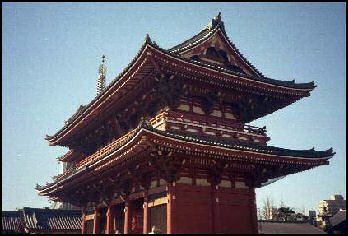
Asakusa Kannon Temple Asakusa District (three stops from Ueno on the subway) is Tokyo's quaintest neighborhood and one of the largest downtown entertainment centers in Tokyo. It used to be a merchant's quarter, with a large number of brothels, kabuki theaters, music halls, and geisha houses. Now it is not so different than other Tokyo entertainment districts.
With the Sensoji Temple at its center, this lively area personifies the atmosphere of old ‘downtown’ Edo and offers glimpses into a more traditional life style. Kappabashi, which sells wholesale anything you would possibly want in the way of dishes, is within easy walking distance. Many traditional events and festivals are held in Asakusa, which still retains the atmosphere of old Tokyo.
Sensoji Temple (in the middle of Asakusa Park) contains a large five-story Buddhist pagoda and is home to the “Thunder Gate,” with its massive red lantern, one of the most popular photo spots in Tokyo. Also known as Asakusa Kannon , the temple enshrines a gold Buddha statue said to have been miraculously netted by a fisherman in A.D. 628. Millions of pilgrims have come from all over Japan over the centuries to see it. During the 1923 earthquake, when Tokyo was engulfed in flames, thousands sought refuse in temple and were saved by its open spaces.
Asakusa Kannon Temple is Tokyo's best known temple. The huge red lantern that hand from Kaminarimon (“Thunder”) Gate weighs more than ton. The pagoda is situated in a beautiful Japanese garden. The temple is also the site of the Sanja Festival in May, a Plant Fair in May, June and July, the Ground Cherry Fair in July and the Battledore Fair in mid-December.
Large weekend crowds visit the temple to make offerings and light incense in the temple buildings and go shopping and play video games at the shops and amusement centers located within the temple grounds. The lively open air market on Nakasmise Dori is a good place to shop for souvenirs. It is filled with stalls selling dolls, kimonos, wigs, crackers, lacquerware, ceramics, paper fans, tourist kitsch, and other stuff. South of the temple a Edo period neighborhood has been recreated on Denboin-dori street. Website: Japan Guide japan-guide.com
Akihabara
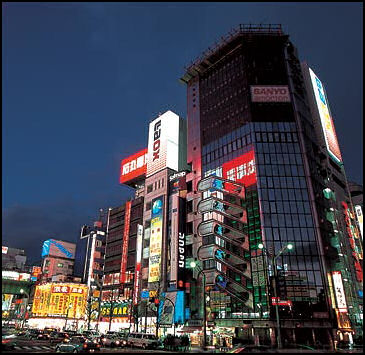
Akihabara (JR Akihabara Station, second stop from Tokyo Station on the JR Yamanote Line) is Tokyo’s “Electric Town.” Arguably the world's largest and most famous electronics district, Akihabara is a mecca for Otaku — a kind of geek that is particularly into anime and computer games. Some are also into “Cosplay.” There are many anime related stores where you can find animation figures, costumes and manga. It is a good place to get electronic products at reduced prices. The street in front of the station is dotted with stores offering almost every kind of electric and electronic device imaginable, including a lot of stuff you won't see in your home country. Most of stuff has been marked down 20 percent or more.
Akihabara is more than a tourist trap or shopping area. It' is a cultural hub. The otaku mecca changed from an electronic district to a software town and is now one of Japan’s leading pop-culture district. It is ground zero for otaku (nerd) culture. It is chock-a-block with small but influential, back-alley anime and manga stores and maid cafes. Within a several block area there are over 80 maid cafes.
On Sundays and holidays some of Akihabara’s streets are closed to traffic. In recent years these areas have attracted “cosplay” performers — people who dress up like manga and anime characters and put on street performances. Some regard the performances as a nuisance because they disrupt the flow of shoppers and there has been some effort to control them. One woman was arrested for putting in a show that climaxed with exposing her underwear. On weekend nights large crowds gather on the east side of JR Akihabara Station to see live street performance of bands and dance groups.
In January 2011, the vehicle-free pedestrian zone in Akihabara that was the site of the 2008 mass murder was re-opened. The street had been a car-free zone since 1973 on Sundays and holidays. In July 2010 all of Akihabara’s promenades reopened. In 2010, a number of duty-free shops were opened to lure foreign customers. Chinese-owned Laox runs the largest duty-free electronic store, followed by Softmap. Store clerks have been hired that speak Chinese, Korean and English . Poster saying say “Welcome” in Chinese hang from the walls of some stores. “The Best Shops of Akihabara — Guide to Japanese Subculture” by Toshimichi Nozoe is available for ¥1,000 by download at http://www.akibaguidebook.com
Websites: Akihabara Tourism Organization akihabara-japan.com ; Akihabara News akihabaranews.com ; JNTO web magazine jw-webmagazine.com/akihabara-area-ultimate-guide ; Go Tokyo gotokyo.org ; otaku story in the Washington Post Washington Post ;
History of Akihabara and Rise an Otaku Mecca
Akihabara got its start as a center of black market activities after World War II. In the 1950s and 60s it was known as the place to buy radios and appliances. In the 1990s it became known for personal computers Over the years a number of shops that specialized in video and computer games and manga- and anime-related products opened up and these have attracted otaku.
Singer-songwriter Haruko Momoi, a longtime Akihabara-goer, told the Yomiuri Shimbun: "Wandering around the streets of Shinjuku and Shibuya by yourself is lonesome. But everyone in Akihabara is alone. So, I didn't feel lonely at all," said singer-songwriter Haruko Momoi, a longtime Akihabara-goer, as she recalls her middle and high school years. "They have specific motives to come here, and video game stores were like salons.” [Source: Takamasa Sakurai, Daily Yomiuri, February 3, 2012]
Asked when Akihabara starting becoming an otaku haven, Momoi said: "In the mid-1990s, a leading video game company began selling a kind of game called 'Bishojo [beautiful girls] Game.' I think that was the turning point. Konami [Digital Entertainment] released a dating simulation computer game Tokimeki Memorial [Heartbeat Memorial] and that is almost surely the origin of the 'moe' concept. Since then, a lot of people have come to Akihabara to buy software and other items, and the area has gradually become a software town. Akihabara was like unmarked, virgin soil with stores enjoying friendly rivalries.
Back then, male visitors dominated, but the number of female visitors has increased thanks to the opening of anime shops such as Animate Ltd. Girls working at Akihabara’s maid cafes, symbols of the area, are frequent visitors to Harajuku. They scrutinize clothing magazines and shops in this fashion mecca on weekends. Their preferences seem to match the maid costumes and culture. "Akihabara and Harajuku are getting closer. Akihabara-goers used to have a deep-rooted complex about Harajuku. But thanks to girls working at maid cafes, the wall between the two is getting lower," Momoi agrees. In Japan, Lolita fashion fans used to hate being identified with cosplayers. But teenage girls today say they like both.
Akihabara Maid Cafes
Role-playing cafes for men are popular in Tokyo. Most have waitresses dressed as French maids and target otaku — geeky fans of manga and anime. The trend reportedly began in the 1990s with a “love simulation” game in which players tried to win a date a with a waitress dressed in a maid costume." Some anthropologists say that one reason role-playing and dressing up are so popular in Japan is because they allow people to briefly escape the extreme social control and rigid norms of everyday life.
In Akihabara there are over 80 maid cafes packed into a few block area and girls in maid costumes are frequently seem on the streets handing out fliers. The first maid cafes opened in Akihabara in 2000 and the popularity gained momentum after they were mentioned in the popular film Densha Otaku. Today there are so many and the competition is so stiff that its said you have to be special to survive.
The cafes where young girls dress up like English or French maids are relatively harmless Most of the time the girls are simply waitresses. They don't even pour drinks or flatter customers like hostesses do. Many of the clients are otaku, Many of the girls are cosplay fans. In Akibara district there are maid cafes, maid bars, maid game center, and foot massage centers and oxygen salons with girls in maid costumes. The firm Candy Fruit rents out pairs of girls in maid outfits to do “entertainment housekeeping." It charges ¥30,000 to send two girls and a chaperon to a customers house for two hours of chatting and cleaning.
Maids at cafes often greet otaku regulars with the greeting oakari (“Welcome Home”). The founder of maid training academy told otaku scholar Patrick Galbraith, “In a world where communication is getting ever weaker the relations between and intimacy established between maid and customer are crucial." Roles are reversed at the Newtype café in Akihabara where young men and pretty boys dress up in maid costumes and serve young women or male customers dressed in drag themselves. To work there the boys have to be cute.
Akihabara Murders
In June 2008, a 25-year-old temporary auto factory worker, Tomohiro Kato, went on a carefully planned rampage, killing seven people’six men and one woman ages 19 to 74 — and injuring 10, in the busy Akiharbara shopping district of Tokyo. Dressed in a pale suit, he drove 95 kilometers from his home and plowed a rented two-ton truck into a crowd and then leaped out and began stabbing bystanders. Afterwards Kato confessed to police he wanted to kill as many people as possible.
Of the 17 that were killed or injured, five were struck by the truck and 12 were stabbed. Kato purposely drove the truck through a pedestrian crossing as people were crossing, trying to kill as many people as possible that way. The truck was traveling 40 to 50 kilometers per hour in a zigzag pattern tp avoid other vehicles. Kato drove around the area for 20 minutes before beginning the attack apparently trying to get the timing right for plowing into the intersection. Three of the five people he hit died.
Kato stopped the truck about 70 meters from the intersection and got out and ran back to the intersection with the a double edge combat knife in his hand, stabbing 12 people in the crowded intersection within one minute. As he ran from the truck he stabbed three people. In the intersection about 100 people were milling around. There he stabbed five people, three of them in the back. One of the victims was a policeman who was assisting victims hit by the truck.
Pedestrians initially thought only traffic accident had taken place. When they realized that a man with a knife was running amok they began to scatter. At this point in the attack Kato stabbed three of the fleeing people in the back.
The entire Akihabara rampage unfolded in less than two minutes. It resulted in the highest death toll for an attack of this kind in postwar history. The Washington Post described the scene as looking like a war zone with “puddles of blood and random shoes on the pavement.” Some of the victims did not even know they had been stabbed. The double edged knife Kato used made it easy for him to thrust deeply and withdraw the blade and repeatedly stab in this way with a minimum effort. One victim whose liver was penetrated by the knife died four hours after the attack in a hospital.
About five minutes after the attack began police officers from a local koban surrounded Kato in a back alley about 50 meters from the intersection. The policeman who first confronted Kato did so with a police baton. Kato managed to slash the policeman’s protective vest three time before the policeman pulled out his gun. At that point Kato dropped his knife. His face was covered with blood.
See Separate Article FAMOUS MULTIPLE MURDERS IN JAPAN: TSUTOMU MIYAZAKI, MYOKO SUMIDA AND THE AKIHABARA KILLER factsanddetails.com
Nakano Broadway; Tokyo’s Real Otaku Meca
Nakano Broadway (Nakano Ward, JR Chuo Line Tozai Subway Line, north exit of Nakano Station) is where the real anime otaku go and hang out now that Akihabara has become too touristy. This shabby shopping arcade-mall is the home numerous anime- and manga-related stores as well as fortune tellers, the Takashi Murakami gallery, a record store devoted to progressive German and Japanese music, vintage and indie bookshops, and Tokyo’s tallest soft serve ice cream cones. Location: 5-52-15 Nakano, Nakano-ku, Tokyo 164-0001, Tel: +81-3-3388-7004}
Tokyo’s Nakano Ward is known both in and outside Japan as an "otaku mecca," and the local government has launched various projects to support manga and anime businesses, in the hope that the area will take the lead in the field of "Cool Japan" pop culture. [Source: Mutsuko Yamada, Yomiuri Shimbun, December 16, 2011]
According to the Yomiuri Shimbun: “The Nakano Ward Office regards subculture as part of its local culture and has opened manga academies as well as inviting related companies to the area. Many manga and anime shops are concentrated in and around the Nakano Broadway shopping center, and the local government plans to play an active role in disseminating information overseas—all helping to nurture Japan’s emergence as a pop culture center.
“Nakano Manga Art Court opened in October 2011 after the local government donated the defunct Momogaoka Primary School as a facility to house several manga and anime academies. Amps, one of the manga and anime academies at the facility, recently began offering classes in four departments—anime, manga, illustration and action figures—and has enrolled about 130 students. The school also has an anime production agency, providing career opportunities for its graduates. Akira Natsukawa, president of Amps, said: "The local government supports us in boosting subculture in this area. I want to train capable people here who can work in the industry."
“The Nakano Ward government says it has had a positive response and plans to attract companies that use anime, manga and action figures to a lot once used by the National Police Academy, on the north side of Nakano Station. Companies targeted include a human resources agency where professional artists in the manga, anime, games, film and music fields can register, as well as a company that releases works by amateur artists. "We hope our efforts will help the growth and development of the subculture industry," a Nakano Ward government spokesperson said.”
Roppongi
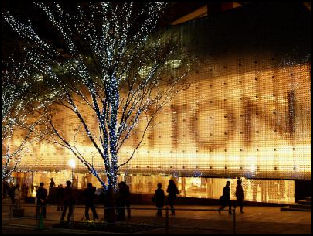
Louis Vuitton store Roppongi (centered around Roppongi Intersection, three kilometers from Ginza) is a nightlife area with a lively and international atmosphere. The bars and snack bars are open to the wee hours of the night. Many foreigners live here and party here. There is freer, less closed atmosphere than in some other Tokyo entertainment districts. In the old days many U.S. servicemen were based around here. It has traditionally been the best place in Japan to score drugs. Many of the nightclubs have African guards. The landscape and atmosphere of the neighborhood has been changed dramatically by Roppongi Hills. Roppongi's name translates into "six trees," from the samurai families who lived here during feudal times.
The town of Roppongi is filled with popular nightspots with visitors from abroad. There are many international shops and restaurants.This area is now developing into an artistic and cultural center.John M. Glionna wrote in the Los Angeles Times, “Once a U.S. serviceman's haunt, the Roppongi district became a respectable business district, then fell back into disrepute, the gentle women in kimonos giving way to mobsters and drug dealers. It's now home to the yakuza, hostess bars, drink spiking and murder. Good or bad, in this famously safe city, Roppongi stands out: elegant one block, seedy the next, a multicultural meeting spot known as Tokyo's most cosmopolitan dusk-to-dawn adult playground. See Crime[Source: John M. Glionna, Los Angeles Times, January 26, 2010]
After World War II, the area was a popular haunt for U.S. servicemen, and visiting military men still sometimes abound here. When the economy was good, foreign-born stockbrokers and stock traders wandered out of their offices in the upscale Roppongi towers to spend their money here, attracting a parade of young, single Japanese women. Website: Japan Guide japan-guide.com
Roppongi Hills
Roppongi is made up of two major apartment, shopping and entertainment complexes: Roppongi Hills and Tokyo Midtown. Roppongi Hills houses a cinema complex, restaurants, and the Mori Art Museum and on the 52nd floor is “Tokyo City View” where a 11m height of glass-walled observatory offers stunning views of the city. Tokyo Midtown includes the Suntor y museum of Arts,21_21 DESIGN SIGHT as well as international restaurants and boutiques.
Roppongi Hills (in Roppongi) opened in April 2003. Laid out on a 64 acre site, it is a huge $4 billion curved glass and metal complex with 200 shops, 70 restaurants, high-rise apartments, a 390-room luxury Grand Hyatt hotel, a nine-screen, 2,100 seat cinema complex, grand stairways and escalators, 70,000 trees, rooftop gardens with a rice paddy in the sky, English, terraces and a rainwater recycling system. The rice paddy produces 135 pounds of rice that is harvested in September. The rice straw that is left over is used to make slippers. Power for Roppongi Hills is supplied by six engines similar to the aircraft engines on P-3C antisubmarine aircraft. They are used because they prevent even split second power outages. It is no surprise then that Roppongi Hills is home to a of trendy technology and foreign companies like Google Japan.
The buildings themselves are located on a 29 acre site referred to as a “city in a city” or an “artelliegence city.” The centerpiece of the complex is the Mori Arts Center, a 54-story office tower that its architect New-York-based Richard Gluckman described as two ships about to crash into one another. The Mori art museum occupies the top six floors and is regarded a center Tokyo contemporary art. The museum has made Asian contemporary art it main focus and has been widely praised for it imaginative use of its exhibition space and for providing explanations in both Japanese and English. It cost around ¥1,000 to get in
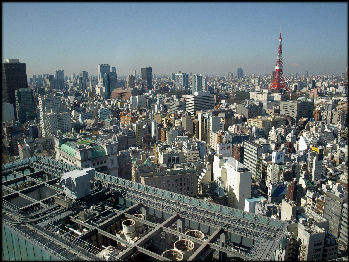
View from Roppongi Hills An observation area offers great views of the city for an admission charge of ¥1,500 and stays open to 1:00am. The shops — which include an Issey Miyake store designed by Naoki Takizawa, a Yohji Yamamoto high-tech store, White Trash Charms, and a Louis Vuitton store,”and restaurants also stay open late. The Vuitton store has a facade with 30,000 glass circles with a lining of 120,000 steel rings. If you have the money and get a reservation try the restaurant established and named after Joel Robuchon, one of France’s most famous chefs.
By all measures Roppongi Hills has been a big success. It attracted 26 million people in its first six months. A giant bronze sculpture of spider, known as “Maman” , by Louise Bourgeois, has become a symbol of the complex, so mcuh so that many young people says “Lets meet at the spider.” The mastermind and financier of Roppongi Hills is Akira Monoru Mori, the largest owner of commercial property in Japan. He wanted to create a cutting edge shopping center that would outdo anything in New York or London. Website: Roppongi Hills site roppongihills.com
Tokyo Midtown
Tokyo Midtown (10 minute walk from Roppongi Hills) opened in March 2007. Built on 10-hectare site whose former occupant was the Defense Agency, the ¥370 billion project embraces a 248-meter-high towers, the tallest skyscrapers in Tokyo, a luxury Ritz Carlton Tokyo on the upper floors; upscale apartments, a museum, business offices on the lower floors; and 130 shops and restaurants in spacious shopping area.
Tokyo Midtown is somewhat similar to Roppongi Hills. There are worried the two may end up competing against one anther. They have similar facilities and are organized according to similar concepts. Other disagree and say they draw customers for the other and help improve the image of Roppongi in the same way that news stores and shopping areas in Time Square upgraded that area of New York. Website: Tokyo Midtown site tokyo-midtown.com
Midtown Tower (in Tokyo Midtown) is the tallest of the six buildings within the Tokyo Midtown and, at 248.1 meters (814 feet), was the tallest office building in Tokyo until 2014. Completed in 2007, the building was designed by Chicago-based architectural firm Skidmore, Owings and Merrill with help from Nikken Sekkei Ltd. and built by the Takenaka and Taisei Corporations. The mixed-use facility has 54 floors that are utilized in different ways. Several conference rooms occupy the entirety of the 4th floor. The 5th floor is the home of the Tokyo Midtown Design Hub, a gallery and space for exhibitions, collaborations and discussions by designers. Tokyo Midtown Medical Center, run in collaboration with Johns Hopkins University, is located on the 6th floor. [Source: Wikipedia]
Unlike similar supertall skyscrapers in the area such as Roppongi Hills Mori Tower, Midtown Tower's top 54th floor is not a visitors' observation deck. Instead, the floor houses building components and maintenance facilities. Floors 45 to 53 are home to Japan's second Ritz-Carlton hotel.The Ritz-Carlton Tokyo. This 248-room hotel offers many notable features including Japan’s most expensive Presidential Suite, available for $20,000 per night, and an "authentic" 200-year-old Japanese teahouse. Four works measuring 8.1 meters in height by American painter Sam Francis appear in the building's lobby, that, along with the second and third floors, is utilized by the hotel.The Ritz-Carlton Suite, billed at US$26,300 per night, was listed at number 9 on World's 15 most expensive hotel suites compiled by CNN Go in 2012.
Modern Art Museums in Roppongi
Roppongi is beginning to challenge Ueno Park as Tokyo’s museum hub especialy when it comes to modern and contemporary art. The New Suntory Museum of Art, with its fine collection of arts, and the 21_21 Design Site, a research museum inspired by Issey Miyake, opened in Roppongi in 2007 as part of the $3 billion Tokyo Midtown Project. The Mori art museum occupies the top six floors of Roppongi Hills and is regarded a center Tokyo contemporary art. The Okura Shukokan Museum, with a historical collection, and an annex for the Sen-oku Hakuko Kan museum are also in Roppongi Hills. Websites: Japan Guide japan-guide.com
Mori Art Museum (the top six floors of Roppongi Hills, Roppongi subway Station) is regarded as a center Tokyo contemporary art. Founded by real estate developer Minoru Mori in 2003, the museum has come to be an important and indispensable presence in the art scene today. Known for organizing solo and group exhibitions of incomparable quality and scale, the museum also actively works with young emerging artists, stages discourses on historical movements, and publishes handsome catalogs. In April 2010, a collection of some the greatest masterpieces of the Museum of Fine Arts in Boston, including works by El Greco and Van Gogh, began a tour of Japan, starting at the Mori Arts Center Gallery. Location: Roppongi Hills Mori Tower 53F, 6-10-1 Roppongi, Minato-ku, Tokyo 106-6150 +81-3-5777-8600
21_21 Design Sight (Tokyo Midtown) is Tokyo’s architecture and design Mecca. The establishment of this space was realized by the Japanese design world’s dream team: initiated by Issey Miyake, architecture by Tadao Ando, and currently co-directed by Miyake, Taku Satoh, and Naoto Fukasawa. 21_21 design sight opened in 2007 on the grounds of Tokyo Midtown with the goal of making a space to hold programs based on everyday things. The three directors take turns organizing and curating exhibitions of their specialties, including architecture, craft, product design, and more. Location: 9-7-6 Akasaka, Minato-ku, Tokyo 107-0052 +81-3-3475-2121
Art Scene in Roppongi
Mutsumi Morita wrote in the Yomiuri Shimbun: “The Roppongi entertainment district in Minato Ward, Tokyo, is transforming itself into an art hub.” The October 2016 “opening of complex665, a commercial building that houses three influential galleries, shows the area is strengthening its offerings for art lovers. The three-story complex is home to the Tomio Koyama Gallery, Taka Ishii Gallery and ShugoArts. The three galleries handle works by prominent contemporary artists such as Mika Ninagawa, Yoko Ono, Daido Moriyama, Nobuyoshi Araki, Ilya Kabakov and Yasumasa Morimura. [Source: Mutsumi Morita, Yomiuri Shimbun, January 11, 2017]
“Across the street, the Piramide Building also houses noteworthy galleries including Ota Fine Arts, Wako Works of Art and Zen Foto Gallery. Galerie Perrotin, with which Takashi Murakami is associated, is scheduled to move into Piramide this year. The French gallery already has bases in Paris, New York, Hong Kong and Seoul. The concentration of galleries in the district is expected to make it a leading venue for contemporary art.
“Complex665 came about after the developer, Mori Building Co., invited well-known galleries to move into the building with the offer of letting the galleries dictate what they wanted in the facility. Tomio Koyama, who moved his gallery from the Kitasando district in Shibuya Ward of Tokyo, pointed to Roppongi’s convenient location as a reason for expecting a larger number of visitors. “We hope to boost the image of Roppongi as an art district with us relocating here,” Koyama said. “Roppongi has added a new dimension as an attractive area to visit during the daytime, rather than just a nightlife entertainment district,” said Fumio Nanjo, director of Mori Art Museum in Roppongi.
”It was Mori Art Museum — founded in 2003 on the 53rd floor of the Roppongi Hills Mori Tower, part of a Mori Building redevelopment project — that became the leading force for giving this district the image of an art hub. From 2007, The National Art Center, Tokyo, the Suntory Museum of Art and 21_21 Design Sight followed suit. The openings made Roppongi the place to see not only contemporary art, but also famed works of Western art and Japanese traditional art and design, broadening the variety of art on offer.
”The art institutions and local shopping districts have jointly held the “Roppongi Art Night” event almost every year since 2009, bringing in about 700,000 visitors on each occasion. Perhaps due to the art offerings, the number of foreign visitors more than doubled from 2006 to 2008. A Japan National Tourism Organization survey on areas that foreign tourists visited in Japan showed 15.9 percent included Roppongi in their visits in 2008, up from 7.9 percent in fiscal 2006. One of the main beneficiaries has been the Suntory Museum of Art, which moved to Roppongi from the Akasaka-Mitsuke area of the same ward. In the last 10 years through last October, approximately 4.3 million people have visited, almost tripling the comparable figure before its relocation.”
GINZA
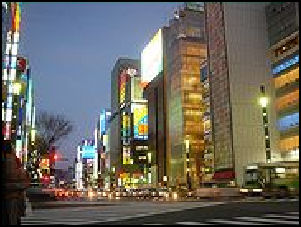
the area around
the Sony showroom GINZA (between the Imperial Palace and Tokyo Bay) is Tokyo's famous bright lights and big prices commercial and shopping area. The most well known spot in Tokyo, it is where you can find $150 cantaloupes, $3,000-a-night hotel suites, and $800 Italian shoes. It is best visited at night when it is lit up with "galaxies of neon advertisements." Among the most popular places are the Ginza Apple Store and Uniqlo’s flagship store.
Ginza is home to art galleries, and a plethora restaurants and boutiques. Every store its seems has a tradition and a culture unique to Ginza. Many of world famous brand boutiques have opened their shops in Ginza. There are large department stores such as Mitsukoshi, Matsuya and many large-size store buildings dotted around 4-chome in particular, where the street meets the intersection of Harumi-dori Avenue. Ginza means a silver mint, and its name derives from establishment of the silver coin mint in the 1600s.
Ginza is defined by Harumi, Chuo and Sotobori streets and covers an area that extends for about 600 meters from east to west and 1.1 kilometers from north to south. Closed to traffic every weekend between noon and 5:00pm, the main streets are lined with massive department stores, upscale boutiques, and fancy nightclubs. In the side streets around it are plush designer shops, art galleries, high tech showrooms and more than 1,000 restaurants.
There aren't many museums, shrines or temples or things of that nature in Ginza. The main landmark is semicircular Wako Cascade at Ginza 4-chrome. In recent years some of the luxury shops have folded and been replaced by American coffee shops and fast food chains, taking a little of the glamor away from the place, while new stores like Bulgari Ginza Tower and Chanel Ginza, designed by architect Peter Marino, have opened, bringing back some of the luster. Websites: Wikipedia Wikipedia ; Wikitravel Wikitravel ; Ginza Concierge ginza.jp ; Tokyo Essentials tokyoessentials.com ; Japan Guide www.japan-guide.com Ginza Map: Tokyo Pocket Guide tokyopocketguide.com
See Separate Article GINZA factsanddetails.com
Shimbashi
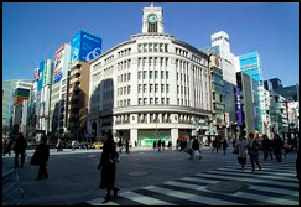
Ginza department store Shimbashi (near Ginza, Tokaido, Yamanote, Yokosuka, Keihin-Tōhoku lines stop at Shimbashi station) is one of the main places in downtown Tokyoites go to enjoy mugs of cold beer and warmed sake and plates of fresh sashimi and skewered yakitori grilled chicken. Laughter, shouts and spirited discussions are interspersed with the clatter-clatter from the train tracks above. Shimbashi ("New Bridge”) Station is a major interchange railway station in Tokyo's Minato Ward. It is a 10-minute walk from the Ginza shopping district, directly south of Tokyo station.
Shimbashi is an after-hours, after-work place with throngs of workers raising a glass and saying Kampai! (“Cheers!”) with their office mates and friends while gobbling down succulent goodies at izakayas (traditional Japanese pubs), undisturbed by the overhead noise from the constant stream of overhead trains and subways. Shimbashi is good place to see how Tokyoites play hard after they work hard. [Source: JNTO, January 2017]
A 1.4-kilometer stretch of road connecting the Shimbashi and Toranomon areas of central Tokyo opened in 2014. The new road is a segment of Loop Road No. 2, a not-yet-completed route that will serve as an important connection between central Tokyo and various venues to be used during the 2020 Tokyo Olympics. The completion of the new underground section created a vast open space above., with a walkway as wide as 13 meters. [Source: Yomiuri Shimbun, March 27, 2014]
Image Sources: 1) 7) Visualizing Culture, MIT Education 2) 10) Twin Isles 3) Hector Garcia 4) Wikipedia 5) 6) 9) 11) 13) 14) Ray Kinnane 8) 12) Andrew Gray Photosensibility
Text Sources: JNTO (Japan National Tourist Organization), Japan.org, Japan News, Japan Times, Yomiuri Shimbun, UNESCO, Lonely Planet guides, New York Times, Washington Post, Los Angeles Times, National Geographic, The New Yorker, Bloomberg, Reuters, Associated Press, AFP, Compton's Encyclopedia and various books and other publications.
Updated in July 2020
